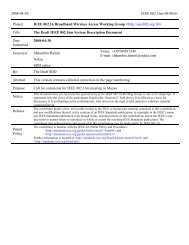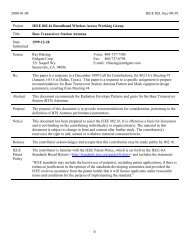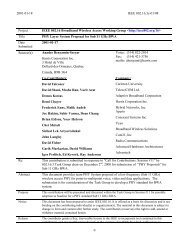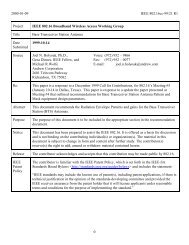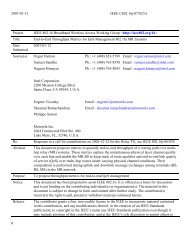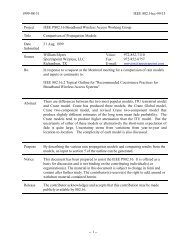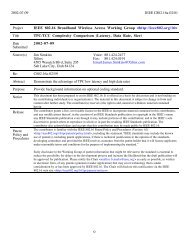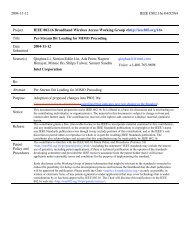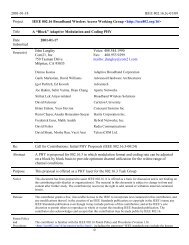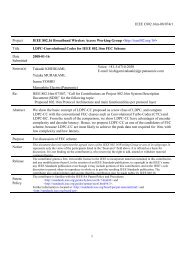802.16.1 Functional Requirements, Rev. 1 - LMSC, LAN/MAN ...
802.16.1 Functional Requirements, Rev. 1 - LMSC, LAN/MAN ...
802.16.1 Functional Requirements, Rev. 1 - LMSC, LAN/MAN ...
You also want an ePaper? Increase the reach of your titles
YUMPU automatically turns print PDFs into web optimized ePapers that Google loves.
123456789101112131415161718192021222324252627282930313233343536373839404142431999-12-17 IEEE 802.16s-99/00r1It is expected that the highest contributor to <strong>802.16.1</strong> system outage will be excessive attenuationdue to atmospheric conditions (e.g., rain rate, droplet size and other factors) [50] [51] [52] [53][72]. <strong>802.16.1</strong> MAC and PHY protocols MUST accommodate atmospheric conditions, perhapsconsuming more radio bandwidth and/or requiring smaller radio propagation distance (radius) tomeet the availability requirements. Since statistical atmospheric conditions vary widely ingeography, the <strong>802.16.1</strong> protocols MUST be flexible in consumed radio bandwidth (spectralefficiency), cell radius, and transmit power to accommodate a rain allowance that varies withgeography [11]. Bandwidth and cell radius are critical components of system/cell capacityplanning (also see section 5.7).<strong>802.16.1</strong> MAC and PHY protocols SHOULD specify functions and procedures to adjust power,modulation, or other parameters to accommodate rapid changes in channel characteristics due toatmospheric conditions.5.5 Error PerformanceThe error rate, after application of the appropriate error correction mechanism (e.g., FEC),delivered by the PHY layer to the MAC layer SHALL meet IEEE 802 functional requirements:The bit error ratio (BER) is 10E-9. Note that this BER applies to a BWA system which is onlyone component of a network’s end-to-end BER. Additionally, each block of data delivered by thePHY to the MAC MUST allow for detection of errors by the MAC (e.g., by CRC) with 1, 2 or 3errored bits (a Hamming Distance of 4) [7]. Note that the size of the data block is TBD.5.6 DelayVariation of delay, or jitter, is important to consider. For example, a high variation of delay canseverely impact telephony services. But generic Internet access can tolerate a high degree ofdelay variation.The end-to-end delay is a subjective metric and depends on an entire application-specific networkencompassing all 7 layers of the OSI model. In a telephony network, for example, the maximumacceptable end-to-end delay for the longest path is RECOMMENDED to be less than 300ms [15][17] [75].The budget for <strong>802.16.1</strong> system transit delay and access delay MUST be derived. [15] [17]. TheMAC layer may have different requirements for each direction, upstream and downstream. In theupstream direction, time MUST be budgeted for requesting bandwidth and contending amongnodes. The budget for <strong>802.16.1</strong> transit delay is suggested to be less than 19.5 ms [15] for“stringent QoS” services.ITU I.356 [73] recommends end-to-end variation (jitter) for “stringent QoS class” to be less than3 ms. Multimedia videoconferencing requires delay variation to be less than 200 ms end-to-end toallow for reasonable synchronization of audio and video streams [17]. It is suggested that thebudget for <strong>802.16.1</strong> systems be 1.5ms [15] for “stringent QoS” services.Please refer to section 6.2, descriptions of QoS parameters.-14-



